By tracking the movements of Denali’s wolves for 30 years, large contributions have been made to the study of wolves -- specifically those within the park boundaries.
Darted wolves become immobilized in a few minutes, and remain down for an hour or two, while we weigh, measure, take a blood sample, and attach a radio collar.
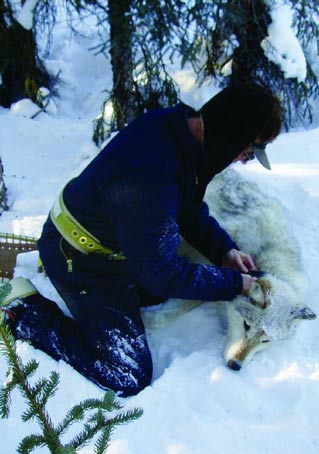
NPS Photo / Thomas Meier
The wolves of Denali National Park (formerly Mount McKinley National Park) were the subject of some of the earliest research on wolf ecology. From 1939 to 1941, Adolph Murie performed ground-breaking studies of wolves, observing wolves and their prey and collecting wolf scats and prey remains.
His work resulted in one of the first major scientific publications about wolves, The Wolves of Mount McKinley (Murie 1944). Continuing the research started by Murie, the National Park Service (NPS) began using aircraft to locate and count wolves in the 1960s (Prasil 1967, Singer 1986). Beginning in 1969, Gordon Haber used aircraft to make prolonged observations of wolf packs, studying their behavior and relations with prey species (Haber 1977).
When the park was expanded into the present Denali National Park and Preserve in 1980, it incorporated the territories of many more wolf packs. A complete survey of the park’s wolf population was undertaken in 1985 (Dalle-Molle and Van Horn 1985), and in the course of that aerial survey, the remains of eight wolves that had been poached from aircraft were found in the park. Concern over the extent of wolf poaching led the NPS to begin extensive wolf research in 1986, using radio collars to keep track of the packs (Mech et al. 1998).
With, on average, more than a dozen wolf packs roaming over many thousands of square miles, radio collars have provided the means to study wolves throughout the park, and throughout the year.
Techniques for Radio-Tracking Wolves
Wolves are a difficult species to monitor. They are inconspicuous and live at low density in a structured population of territorial packs (Mech and Boitani 2003). In Alaska, wolves live at particularly low densities, and in many areas, human access is limited to air travel.
If wolf pack territories were regular and predictable, wolf surveys would be much easier, but it is seldom possible to predict the arrangement of pack territories from studying the terrain.
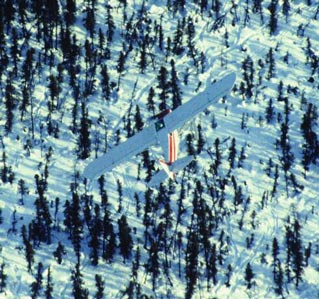
NPS Photo / Thomas Meier
Wolf pack territories overlap one another and change over time. Effective monitoring needs to address not only wolf numbers but the spatial structure of the population. Radio tracking of wolves in Denali has revealed that the park’s wolf population is made up of a shifting mosaic of pack territories. As packs die out and are replaced by new packs, territory boundaries and patterns of habitat use change.
The first step in radio-collaring wolves involves locating packs by tracking them in the snow. This is usually done in November or March, when days are long. The best conditions are a few days after a fresh snowfall, when wolf packs have left a trail. Once a pack is located, researchers dart one or two wolves from a helicopter. Over the years, we have learned the advantage of capturing the leading members of the pack. Wolf packs are typically made up of a breeding pair and their offspring.
While most of those offspring eventually leave the pack, the breeding pair can be relied upon to stay. As the wolf pack travels, the breeding pair usually lead the way, and it is those twowhich we attempt to tranquilize. Darted wolves become immobilized in a few minutes, and remain down for an hour or two, while we weigh, measure, take a blood sample, and attach a radio collar (Figure 1).
Collared wolves are tracked from a small airplane equipped with wing-mounted radio antennae (Figure 2).
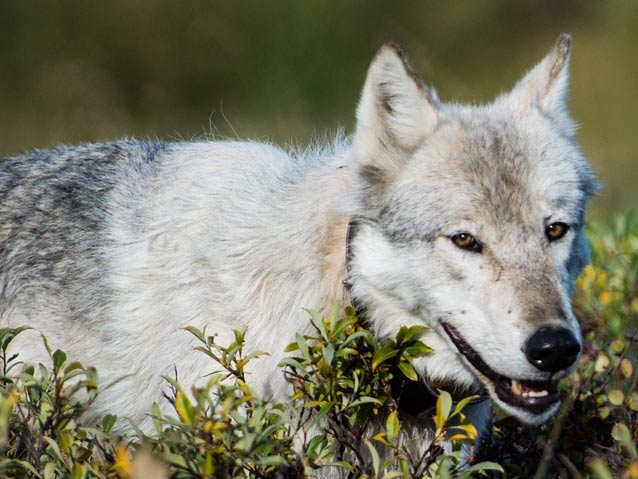
NPS Photo / Kent Miller
From such a plane, researchers are able to locate the collared wolf, circle its location, and usually see the wolf pack. This allows the counting of wolves in a pack and observation of their behavior (Figures 3, 4). Collaring also allows researchers to collect other valuable data, including den site use, pup production, predation patterns, dispersal, and wolf mortality. The basic unit of information is the wolf’s location, usually described as coordinates of latitude and longitude. It is these fragments of data, providing a point on a map or a few characters in a database, that make up the building blocks of wolf research (Figure 5). By obtaining enough locations for a wolf pack, its territory is outlined. By outlining the territories of a cluster of packs and counting the number of wolves in each pack, we can describe the population.
Wolf Pack Territories
Wolf pack territories are typically drawn by connecting the outermost locations of the pack’s known movements on a map (Figure 6). As more locations are added, the territory gets bigger, until the collection of locations includes all of the places where the pack is likely to go. Various studies have estimated that 30 to 150 locations are needed to adequately describe a wolf pack territory. Burch et al. (2005) found that there was no “magic number” of radio locations guaranteed to adequately describe a wolf pack territory, but that monitoring a number of adjacent packs in a block allows territories to be defined with fewer locations.
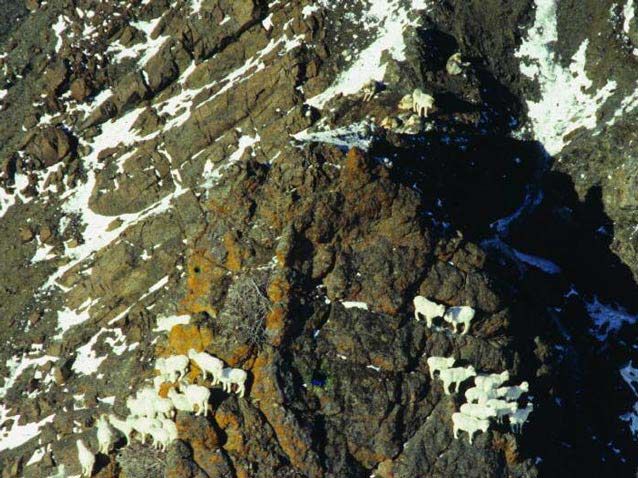
NPS Photo / Thomas Meier
The crucial question is whether pack territories are sufficiently defined to ensure that undetected wolf packs do not exist between the monitored packs. More sophisticated treatment of location data is possible, including kernel analyses that show the relative intensity with which different parts of the territory are used (Figure 6).
Wolf Dispersal
In addition to describing pack territories, radio telemetry allows the study of wolves that leave their home territories. On average, 28% of wolves in Denali leave their packs each year. Most leave alone, but some pairs disperse, and in one case 11 wolves left together. Male and female wolves disperse in approximately equal numbers and for similar distances.
At least 14 wolves have dispersed long distances away from Denali (Figure 7), and dozens more wolves dispersed shorter distances, within the study area or just outside of it. The longest documented dispersal was by a female wolf that left the Headquarters Pack and was shot by an Inupiat hunter near the Canning River, 40 miles from the Arctic Ocean and (in a straight line) 435 miles from Denali.
Dispersing wolves seldom remain alone for long. In nearly 20 years of wolf research, only one territorial, solitary-living wolf has been found in the park. All other “lone” wolves that survived for more than a few months either started new packs, joined existing packs, or dispersed far away and were lost from monitoring. A surprising result of wolf studies in Denali has been the frequent observations of existing packs adopting unrelated wolves (Meier et al. 1995).
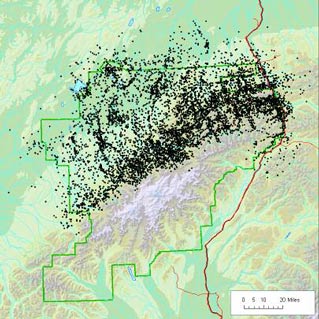
Wolf Pack Formation
Typically, a new wolf pack is formed when two or more dispersing wolves come together in an area that is not currently occupied by wolves and take up residence there. We have observed many cases of new pair and pack formation in Denali. Many of them have been unsuccessful, when a pair of wolves sought to carve out a territory between existing wolf packs, or attempted to live in an area without a year-round food supply.
Most of these unsuccessful pairs were killed by neighboring packs. Several new packs that did succeed were formed when a large wolf pack killed off a neighboring pack and colonized the vacant area with its own members.
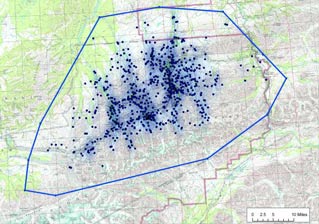
Another way for new packs to be formed is for an existing pack to split in two. There have been four cases where large wolf packs split roughly in half, subdividing the territory into two new territories. The largest wolf packs in Denali have been just under 30 wolves, and packs of more than 15 or 20 wolves do not seem to last for long. Either the pack splits, or members die or disperse away. A similar pattern has been seen as wolves become established in Yellowstone (Smith et al. 2005).
Relationships Between Pack Territories
The pack territories, as they existed in spring 2005, form a sort of sloppy jigsaw puzzle, with overlap between packs in some areas and spaces between packs in others (Figure 8). These territories are based on a limited number of wolf locations, and so they do not show the full extent of a pack’s movements. If they did, overlap between packs would be even more extensive. Some overlap is actually displacement over time, as one pack takes over an area formerly occupied by another. But much of the overlap between packs is real, and several packs have made forays that took them complete-y across neighboring pack territories. This “trespassing” of one pack into another’s territory is not without risk.
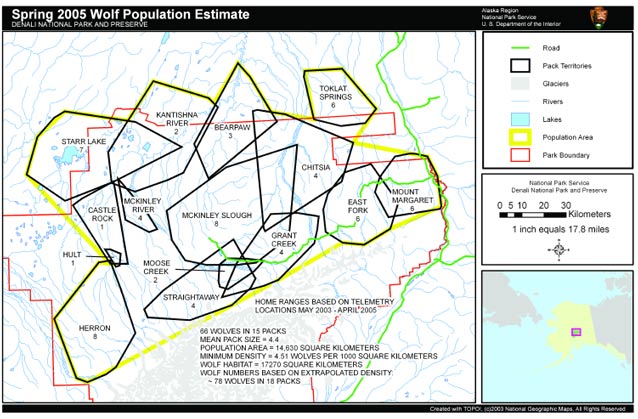
At least 60% of wolf deaths in Denali come from wolves being killed by other wolf packs. A further risk occurs when the wolves travel to places where it is legal to trap or shoot wolves. Nearly every winter, news stories docu-ment the killing of one or two park wolves outside of the park boundaries.
Using GPS Collars to Learn More About Wolf Movements
Though the numbers fluctuate year to year, there are often around seven wolves in the park wearing collars that allow researchers to determine location information with a Global Positioning System (GPS) receiver.
The data is collected once per day and then uploaded through a satellite. While this method provides no information on wolf behavior, pack sizes, or pup production, it does provide enough location points to accurately depict a pack’s territory (Figure 9).
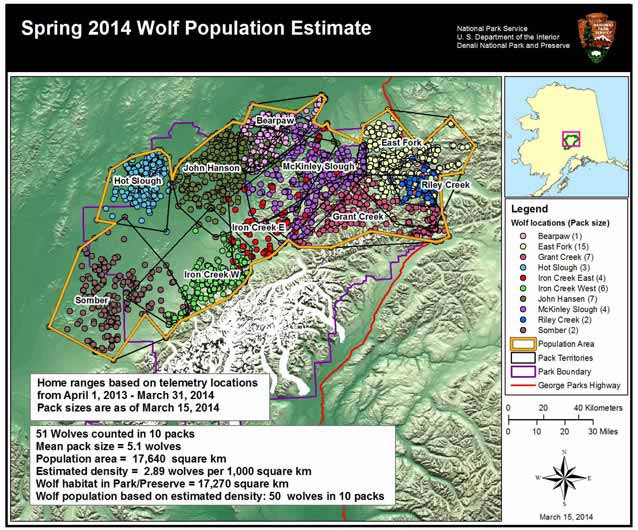
By comparing conventional telemetry (locations from aircraft) with daily GPS locations, we see that the larger numbers of locations obtained from GPS collars result in significantly larger estimates of territory size (Figure 10). Combined with periodic flights for visual observations of packs, GPS collars have the potential to provide much more complete data on wolf movements.
Conclusions
By tracking the movements of Denali’s wolves for 20+ years, large contributions have been made to the study of wolves, specifically those within the park boundaries. The park’s wolf population is more fluid and dynamic than had been expected, and wolf numbers vary two- or three-fold, depending on food supply.
The packs are not static, but have finite lifespans and are replaced by other packs. Most of this flux results from strife between the various packs. Most importantly, the more closely one observes a wolf pack or a wolf population, the more new phenomena and unique events are witnessed. Wolves and wolf packs are dynamic. They demonstrate their intelligence and impressive physical abilities by occasionally doing something that you least expect.
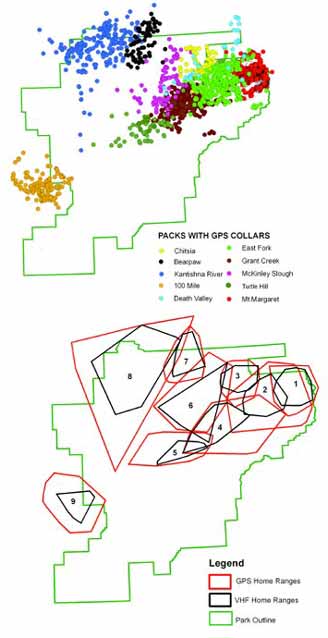
Figure 9: GPS collar locations of 10 wolf packs over a two-year period, 2003-2005.
Figure 10: Comparison of home ranges determined by conventional (boundaries in black) and GPS telemetry (boundaries in red).
1 - Headquarters Pack;
2 - East Fork Pack;
3 - Chitsia Pack;
4 - Grant Creek Pack;
5 - Turtle Hill Pack;
6 - McKinley Slough Pack;
7 - Bearpaw Pack;
8 - Kantishna River Pack;
9 - 100 Mile Pack.
References
Burch, J.W., L.G. Adams, E.H. Follmann, and E.A. Rexstad. 2005.
Evaluation of wolf density estimation from radiotelemetry data. Wildlife Society Bulletin. in press.
Dalle-Molle, J., and J. Van Horn. 1985.
Wolf survey 1985, Denali National Park and Preserve. National Park Service survey and inventory report AR-85-11.
Haber, G.C. 1977.
Socio-ecological dynamics of wolves and prey in a subarctic ecosystem. Ph.D. dissertation, University of British Columbia, Vancouver.
Mech, L.D., L.G. Adams, T.J. Meier, J.W. Burch, and B.W. Dale. 1998.
The Wolves of Denali. University of Minnesota Press. Minneapolis, MN.
Mech, L.D., and L. Boitani. 2003.
Wolf social ecology. In Wolves: Behavior, Ecology, and Conservation, edited by L.D. Mech and L. Boitani. University of Chicago Press. Pages 1-34.
Meier, T.J., J.W. Burch, L.D. Mech, and L.G. Adams. 1995.
Pack structure and genetic relatedness among wolf packs in a naturally regulated population. In Ecology and Conservation of Wolves in a Changing World: Proceedings of the Second North American Symposium on Wolves, edited by L.N. Carbyn, S.H. Fritts, and D.R. Seip. Canadian Circumpolar Institute, University of Alberta, Edmonton. Pages 293-302.
Murie, A. 1944.
The wolves of Mount McKinley. Fauna Series No. 5. National Park Service. Washington, DC.
Prasil, R. 1967.
Aerial wolf survey, Denali National Park, March 1- 11 and April 20 – 23. Denali National Park Files. Denali Park, Alaska.
Singer, F.J. 1986.
History of caribou and wolves in Denali National Park and Preserve – appendices. U. S. National Park Service Research and Resource Management Report AR-11. Anchorage, Alaska.
Smith, D.W., D.W. Stahler, and D.S. Guernsey. 2005.
Yellowstone wolf project: Annual report, 2004. National Park Service, Yellowstone Center for Resources, Yellowstone National Park, Wyoming YCR-NR-2005-02.
Part of a series of articles titled Alaska Park Science - Volume 5 Issue 1: Scientific Studies in Denali.
Last updated: March 19, 2015
